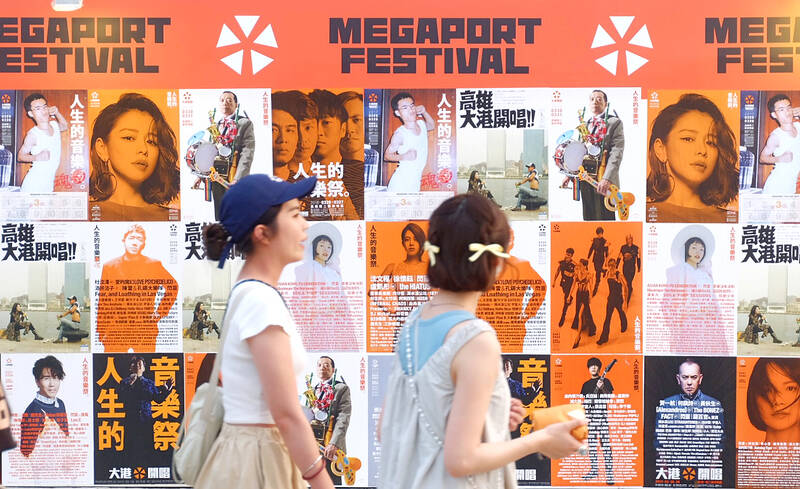Hundreds of young people were head-banging hard at the free stage of the Megaport Festival (大港開唱), the largest annual music event in Taiwan, held in Kaohsiung (高雄) at the end of last month.
Southeast Asian Punk quintet Southern Riot played several songs that really got the crowd going.
“I can’t understand what they say, but I feel their spirit,” says Lai Chien-te (賴謙德), an audience member from Tainan, sporting a Mohawk-hairstyle, boots and a Sex Pistols t-shirt.

Photo: Muhammad Irfan
Southern Riot is an Indonesian band based in Pingtung. The group was formed by several migrant workers and they’re not the only outfit of their kind to be made up of migrant workers. In fact, music made by that community is becoming quite a thing on the sonic landscape. Last year, Jubah Hitam, an Indonesian metal band based in Chiayi, also formed by Indonesian migrant workers, found themselves under the spotlight on the Megaport stage.
Fred Hsieh (謝宗翰) and Shawn Hsu (許瀧尹), the program directors of Megaport, say the participation of the migrant worker community at the festival reflects the social reality in Taiwan. They say Megaport is committed to giving different groups of people the space to express themselves musically and tell their story.
“I believe that bands formed by migrant workers and those formed in their home countries will have very different perspectives... which I think is something that Megaport Festival can continue to explore,” Hsu says.

Photo: Muhammad Irfan
Taiwan is geographically close to Southeast Asia, so the festival organizers hope Megaport can be a starting point for Taiwan’s younger generation to step out of their comfort zone and get to know their regional neighbors a bit better.
CULTURAL EXCHANGE
Wu Ting-kuan (吳庭寬), a cultural activist and researcher of the music made by migrant workers in Taiwan, appreciates Megaport commitment to cultural exchange and diversity. Before Megaport, migrant workers could only perform at corporate events, providing little scope for interacting with the local scene, he says.
“Their performances were not considered as primary content but only to promote the ideology of multiculturalism by the government, NGOs or companies, which is different from Megaport’s focus on their music,” Wu says.
Wu also appreciates how accepting local music fans are. However, he feels that by simply labelling them as “a migrant worker band” there is still some othering going on. Wu says that in the context of the music community, it would be better if bands were not categorized by their ethnic or class identity but simply by their music.
As a person who loves punk music, Lai says Southern Riot surprised him by the quality of their songs and hopes their presence on the festival bill will shine a more compassionate light on Taiwan’s migrant workers generally.
“Awareness of migrant workers and the issues they face is increasing,” says Lai. “But Taiwan has a lot of internal problems, including how migrant workers are treated.”

Oct. 21 to Oct. 27 Sanbanqiao Cemetery (三板橋) was once reserved for prominent Japanese residents of Taipei, including former governor-general Motojiro Akashi, who died in Japan in 1919 but requested to be buried in Taiwan. Akashi may have reconsidered his decision if he had known that by the 1980s, his grave had been overrun by the city’s largest illegal settlement, which contained more than 1,000 households and a bustling market with around 170 stalls. Fans of Taiwan New Cinema would recognize the slum, as it was featured in several of director Wan Jen’s (萬仁) films about Taipei’s disadvantaged, including The Sandwich

“Wish You Luck is not just a culinary experience, it’s a continuation of our cultural tradition,” says James Vuong (王豪豐), owner of the Daan District (大安) Hong Kong diner. On every corner of Kowloon, diners pack shoulder-to-shoulder over strong brews of Hong-Kong-style milk tea, chowing down on French Toast and Cantonese noodles. Hong Kong’s ubiquitous diner-style teahouses, known as chachaanteng (茶餐廳), have been a cultural staple of the city since the 1950s. “They play an essential role in the daily lives of Hongkongers,” says Vuong. Wish You Luck (祝您行運) offers that same vibrant melting pot of culture and cuisine. In

Much noise has been made lately on X (Twitter), where posters both famed and not have contended that Taiwan is stupid for eliminating nuclear power, which, the comments imply, is necessary to provide the nation with power in the event of a blockade. This widely circulated claim, typically made by nuclear power proponents, is rank nonsense. In 2021, Ian Easton, an expert on Taiwan’s defenses and the plans of the People’s Liberation Army (PLA) to break them, discussed the targeting of nuclear power plants in wartime (“Ian Easton On Taiwan: Are Taiwan’s nuclear plants safe from Beijing?”, April 12, 2021). The

Artificial intelligence could help reduce some of the most contentious culture war divisions through a mediation process, researchers say. Experts say a system that can create group statements that reflect majority and minority views is able to help people find common ground. Chris Summerfield, a co-author of the research from the University of Oxford, who worked at Google DeepMind at the time the study was conducted, said the AI tool could have multiple purposes. “What I would like to see it used for is to give political leaders ... a better sense of what people ... really think,” he said, noting surveys gave